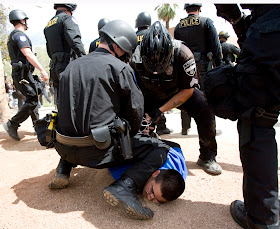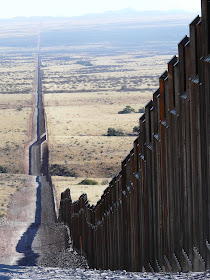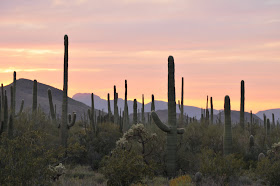Joel Olson has lived in Arizona for over 25 years. He is a member of the Flagstaff Repeal Coalition.
With the passage of the notorious anti-immigrant bill SB 1070 last spring, the outlawing of ethnic studies as of January 1, the gutting of the school and university systems, the collapsed housing market, the high unemployment rates, and now the shooting of Congresswoman Gabrielle Giffords, you might be wondering what it’s like to live in Arizona right about now.
It ain’t easy.
But it helps to put Giffords’s shooting in historical perspective, which is defined by two things in Arizona: corruption and class struggle. And ironically, this perspective gives me hope about the radically democratic future of my home state.
Arizona’s economy was founded on the “Five C’s:” copper, cotton, cattle, citrus, and climate (tourism). These C’s were controlled by big mining and agricultural interests and real estate developers. Corruption was commonplace as they manipulated the political system for their benefit. A group of these capitalists, called the Phoenix 40, controlled state politics until the 1970s, when the political establishment opened up some. But even after their rule, the state capitol has always been a place to lie, bribe, and scam your way to what you want. If the names Don Bowles, Evan Mecham, AZ scam, Fife Symington, or the Keating 5 (which included Senator John McCain) mean anything to you, then you know that corruption is as plentiful as the parking here. And I haven’t even mentioned Maricopa County Sheriff Joe Arpaio or State Senator Russell Pearce, the tweedle-dee and tweedle-dum of racist nativism.*
SB 1070 and Giffords’s shooting, in other words, are but the latest of a storied history of corrupt cowboy capitalism.
Such tomfoolery is part of the class struggle in the Grand Canyon State. Three classes matter in Arizona: elites, the white middle class, and the working class. The elites come mainly from the agriculture/mining, tourism, and construction/real estate sectors (with an emerging tech sector). They are the masters of the corruption I described. But in a system of majority rule, elites need a junior partner to dominate. This is where the white middle class steps in.
The white middle class is the engine of suburban development here. The new housing developments, strip malls, and big box stores that pop up almost daily (until the recession, at least) are built for and fueled by this class. Many in this class run small businesses related to the main sectors of the economy, such as ranching, construction, landscaping, and pool maintenance. Many are retirees who used to manage businesses in other states. This small business atmosphere contributes to the libertarian, Barry Goldwater-style political culture of the state.
For years, this relationship has been mutually beneficial. While legal segregation never took deep root in this state (most of Arizona’s explosive growth took place after Brown v. Board of Education was decided in 1954), unofficial practices have kept many neighborhoods and schools comfortably white for decades, and the best jobs have been traditionally denied to Chicanos and Natives. (With a Black population of just three percent, the racially “out” groups in this state have historically been Chicanos, Mexicans, and indigenous peoples.) Politicians have successfully tied these practices to the laissez-faire economic policies of the elites, giving whites the sense that their success is due strictly to their own work ethic rather than being facilitated by white privilege. As a result, many white middle and working class Arizonans identify with the success—and conservative politics—of the elites.
This collusion has created an anything-goes capitalism mixed with a suburban consciousness. Call my state the Wild West or suburban hell—they’re both accurate to a large degree.
But the partnership has been fraying in the last two decades. Pressures to diversify corporations, universities, and governments have led elites to support various multicultural initiatives, which middle class whites resent. (Arizona voters in November voted to outlaw affirmative action by a wide margin.) The state’s Latino population has outpaced white growth, and the state is now nearly one-third Latino. Areas that were once comfortably white now have Spanish-language business signs. More and more schoolchildren have brown faces—even in the “good” schools. Cars roll down formerly white streets bumping music whose percussion comes from a tuba.
Further, middle class whites increasingly see elites in collusion with the Brown working classes rather than them. They have reasons for believing this. Agriculture, construction, and tourism all depend on a highly exploitable, low-paid working class, which makes migrant labor desirable. Undocumented labor makes up 27% of all construction workers, 60% of agricultural workers, 25% of restaurants workers, and 51% of all landscaping workers in Arizona. This sets small business interests—who usually can’t take advantage of such labor—into a tizzy. It sets off many other middle and working class whites as well, who feel that “they” are stealing “our” jobs. This is the political power behind SB 1070—a law that Arizona’s elites largely oppose.
The frayed alliance between these two classes has created the political mess this state is in today. It is the story behind SB 1070, HB2281 (the anti-ethnic studies law), the elimination of affirmative action, the attack on the public education system, the attack on public workers for enjoying “Cadillac” pension plans, and Giffords’s shooting. The alleged shooter, Jared Loughner, is not only of the white middle/working class, his addled mind is a gross exaggeration of its contradictions and confusions. Of course Loughner is probably crazy, but his mental health—and even his ideology—are not the point. What matters is that the conflict over this frayed class alliance—and all the political vitriol it has generated by Tea Partiers and others—pointed his illness toward Gabrielle Giffords.
In the face of this mess, it is the working class—largely Brown, largely poor, largely poorly educated, largely ignored—that represents the best hope to build a new Arizona within the corrupted shell of the old. Exploited by the elite, despised by many whites, and largely shut out of the political system, this class has had to make its own way through the state’s crazy political landscape.
With a weak Democratic Party, a labor movement crippled by “right to work” laws, a small civil rights contingent, few political nonprofits, and almost no organized left, Arizona’s working class is turning to grassroots democracy, operating outside the “official” political channels and fearlessly making political demands that challenge the pillars of laissez-faire capitalism itself. This path they are carving is quite possibly a model for working class struggles throughout the nation.
Take the grassroots fight against SB 1070, for example. The Tierra y Libertad Organization in Tucson has been a leader in opposing SB 1070. But it is also creating a new model of democracy. Declining to become a 501(c)3 nonprofit organization, they raise funds through the community, which they use support their struggle for the self-determination of its base communities. In Phoenix, Puente has organized the major immigrant rights demonstrations in Arizona, but they are also organizing neighborhood meetings throughout the Valley of the Sun. In Phoenix and Flagstaff, the Repeal Coalition (I’m a member of this group) demands that all persons in a global economy be free to live, love, and work wherever they please, and they demand that ordinary people have a full say in those affairs that affect their daily lives. The undocumented workers, moms, and college students who make up the group don’t seem to worry that these demands are deeply radical and disrupt the very functioning of Arizona politics as it currently operates. These groups work with others, such as Border Action Network, No More Deaths, and Arizona Interfaith, that are organized in a traditional nonprofit format but nevertheless encourage face-to-face democracy and are courageously fighting 1070 and myriad other evils.
These working-class struggles suggest a new Arizona. They suggest a world in which working people decide the fate of the community, not the rich. They suggest a world in which democracy rather than white privilege decides how to allocate resources. They suggest a world in which borders are tools of the bosses rather than walls that “defend sovereignty” or “prevent terrorism.”
This class will not win for a while. The elites and the white middle classes are yet too powerful. This coming year, Arizona politicians will gut the Fourteenth Amendment’s guarantee of birthright citizenship, defund public education until it barely operates, and do many more stupid things. But as elites and the white middle class continue to bicker, the Arizona working class continues to learn lessons, develop leadership, practice grassroots democracy, and make demands that seem “unreasonable” today but might tomorrow become as obvious as the multiplication table.
Corruption, elite domination, and white favoritism are the most important factors in understanding Arizona’s strange political history, including this latest episode. But class struggle against it is key to understanding why the nation’s strangest state may soon be in the vanguard of struggles for real freedom. Those involved in such struggles stand like saguaros in this beautiful state, even as the snakes and scorpions scurry about us.
The frayed alliance between these two classes has created the political mess this state is in today. It is the story behind SB 1070, HB2281 (the anti-ethnic studies law), the elimination of affirmative action, the attack on the public education system, the attack on public workers for enjoying “Cadillac” pension plans, and Giffords’s shooting. The alleged shooter, Jared Loughner, is not only of the white middle/working class, his addled mind is a gross exaggeration of its contradictions and confusions. Of course Loughner is probably crazy, but his mental health—and even his ideology—are not the point. What matters is that the conflict over this frayed class alliance—and all the political vitriol it has generated by Tea Partiers and others—pointed his illness toward Gabrielle Giffords.
In the face of this mess, it is the working class—largely Brown, largely poor, largely poorly educated, largely ignored—that represents the best hope to build a new Arizona within the corrupted shell of the old. Exploited by the elite, despised by many whites, and largely shut out of the political system, this class has had to make its own way through the state’s crazy political landscape.
With a weak Democratic Party, a labor movement crippled by “right to work” laws, a small civil rights contingent, few political nonprofits, and almost no organized left, Arizona’s working class is turning to grassroots democracy, operating outside the “official” political channels and fearlessly making political demands that challenge the pillars of laissez-faire capitalism itself. This path they are carving is quite possibly a model for working class struggles throughout the nation.
Take the grassroots fight against SB 1070, for example. The Tierra y Libertad Organization in Tucson has been a leader in opposing SB 1070. But it is also creating a new model of democracy. Declining to become a 501(c)3 nonprofit organization, they raise funds through the community, which they use support their struggle for the self-determination of its base communities. In Phoenix, Puente has organized the major immigrant rights demonstrations in Arizona, but they are also organizing neighborhood meetings throughout the Valley of the Sun. In Phoenix and Flagstaff, the Repeal Coalition (I’m a member of this group) demands that all persons in a global economy be free to live, love, and work wherever they please, and they demand that ordinary people have a full say in those affairs that affect their daily lives. The undocumented workers, moms, and college students who make up the group don’t seem to worry that these demands are deeply radical and disrupt the very functioning of Arizona politics as it currently operates. These groups work with others, such as Border Action Network, No More Deaths, and Arizona Interfaith, that are organized in a traditional nonprofit format but nevertheless encourage face-to-face democracy and are courageously fighting 1070 and myriad other evils.
These working-class struggles suggest a new Arizona. They suggest a world in which working people decide the fate of the community, not the rich. They suggest a world in which democracy rather than white privilege decides how to allocate resources. They suggest a world in which borders are tools of the bosses rather than walls that “defend sovereignty” or “prevent terrorism.”
This class will not win for a while. The elites and the white middle classes are yet too powerful. This coming year, Arizona politicians will gut the Fourteenth Amendment’s guarantee of birthright citizenship, defund public education until it barely operates, and do many more stupid things. But as elites and the white middle class continue to bicker, the Arizona working class continues to learn lessons, develop leadership, practice grassroots democracy, and make demands that seem “unreasonable” today but might tomorrow become as obvious as the multiplication table.
Corruption, elite domination, and white favoritism are the most important factors in understanding Arizona’s strange political history, including this latest episode. But class struggle against it is key to understanding why the nation’s strangest state may soon be in the vanguard of struggles for real freedom. Those involved in such struggles stand like saguaros in this beautiful state, even as the snakes and scorpions scurry about us.
* For the uninitiated or un-Arizonan: Don Bowles was an Arizona Republic reporter who was murdered by a car bomb in 1976 while investigating connections between Arizona elites and the Mafia. Evan Mecham was a racist governor (he was a John Birch Society supporter) from 1987-1988 who was impeached for obstruction of justice and misuse of government funds. The Keating 5 were five U.S. Senators, including Arizona Senators John McCain and Dennis DeConcini, who were accused of corruption in 1989 for illegally intervening on behalf of Charles Keating, whose Lincoln Savings and Loan bank collapsed, causing thousands to lose their life savings. “AZ scam” was a bribery and money laundering scandal that several state legislators were convicted of in 1991. Fife Symington, the governor of Arizona from 1991-1996, was impeached and indicted for 23 counts of fraud and extortion.
















No comments:
Post a Comment